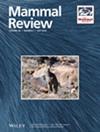Three Decades of Research on Iberian Wild Ungulates: Key Insights and Promising Research Avenues
IF 4.4
2区 生物学
Q1 ECOLOGY
引用次数: 0
Abstract
- The Iberian Peninsula is witnessing ever-faster environmental changes, and new challenges for wild ungulates are continuously emerging as they become more abundant and widespread.
- We conducted a systematic review to analyse the knowledge on wild ungulates inhabiting the Iberian Peninsula. We used Web of Science and Scopus search engines, complemented by searches in nonindexed journals, to examine peer-reviewed articles published between January 1990 and July 2023.
- The annual average growth rate in the number of publications was 17%. Most studies focussed on diseases and pathogens (36%), physiology, endocrinology and reproduction (19%), and behaviour, population and community ecology (17%). Red deer and wild boar are the most targeted species in scientific literature, followed by the Iberian wild goat, roe deer, fallow deer, Southern chamois, mouflon and aoudad.
- We identify key knowledge gaps that deserve further attention such as the ecological and social impacts of (re)introductions, the effects of increasing ungulate densities on ecosystem integrity and the impact of different hunting and management techniques (some unique to the Iberian Peninsula) on population dynamics. We also highlight the need to stimulate Iberian collaboration and extend the discussion to a wider range of stakeholders to integrate different perspectives on the research agenda for Iberian wild ungulates.


伊比利亚野生有蹄类动物研究三十年:关键见解和有前途的研究途径
伊比利亚半岛的环境变化速度越来越快,随着野生有蹄类动物数量的增加和分布范围的扩大,它们面临的新挑战也不断出现。我们对栖息在伊比利亚半岛的野生有蹄类动物的知识进行了系统的回顾分析。我们使用Web of Science和Scopus搜索引擎,并辅以对非索引期刊的搜索,对1990年1月至2023年7月间发表的同行评议文章进行了研究。出版物数量的年平均增长率为17%。大多数研究集中于疾病和病原体(36%)、生理学、内分泌学和生殖学(19%)以及行为、人口和社区生态学(17%)。在科学文献中,马鹿和野猪是最受攻击的物种,其次是伊比利亚野山羊、狍子、黇鹿、南羚羊、驼鹿和阿乌达。我们确定了值得进一步关注的关键知识空白,例如(重新)引入的生态和社会影响,有蹄类密度增加对生态系统完整性的影响,以及不同狩猎和管理技术(一些是伊比利亚半岛特有的)对种群动态的影响。我们还强调需要促进伊比利亚合作,并将讨论扩展到更广泛的利益相关者,以整合关于伊比利亚野生有蹄类研究议程的不同观点。
本文章由计算机程序翻译,如有差异,请以英文原文为准。
求助全文
约1分钟内获得全文
求助全文
来源期刊

Mammal Review
生物-动物学
CiteScore
12.20
自引率
4.10%
发文量
29
审稿时长
>12 weeks
期刊介绍:
Mammal Review is the official scientific periodical of the Mammal Society, and covers all aspects of mammalian biology and ecology, including behavioural ecology, biogeography, conservation, ecology, ethology, evolution, genetics, human ecology, management, morphology, and taxonomy. We publish Reviews drawing together information from various sources in the public domain for a new synthesis or analysis of mammalian biology; Predictive Reviews using quantitative models to provide insights into mammalian biology; Perspectives presenting original views on any aspect of mammalian biology; Comments in response to papers published in Mammal Review; and Short Communications describing new findings or methods in mammalian biology.
 求助内容:
求助内容: 应助结果提醒方式:
应助结果提醒方式:


